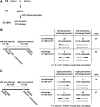Trans-centromere effects on meiotic recombination in the zebrafish
- PMID: 20980237
- PMCID: PMC3018315
- DOI: 10.1534/genetics.110.124081
Trans-centromere effects on meiotic recombination in the zebrafish
Abstract
We report that lack of crossover along one chromosome arm is associated with high-frequency occurrence of recombination close to the opposing arm's centromere during zebrafish meiotic recombination. Our data indicate that recombination behavior on the two arms of a chromosome is linked. These results inform mapping strategies for telomeric mutants.
Figures

References
-
- Buonomo, S. B., R. K. Clyne, J. Fuchs, J. Loidl, F. Uhlmann et al., 2000. Disjunction of homologous chromosomes in meiosis I depends on proteolytic cleavage of the meiotic cohesin Rec8 by separin. Cell 103 387–398. - PubMed
-
- Colombo, P. C., and G. H. Jones, 1997. Chiasma interference is blind to centromeres. Heredity 79(Pt 2): 214–227. - PubMed
-
- Gestl, E. E., E. J. Kauffman, J. L. Moore and K. C. Cheng, 1997. New conditions for generation of gynogenetic half-tetrad embryos in the zebrafish (Danio rerio). J. Hered. 88 76–79.
Publication types
MeSH terms
Grants and funding
LinkOut - more resources
Full Text Sources
Molecular Biology Databases

